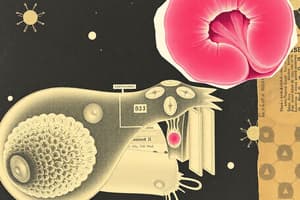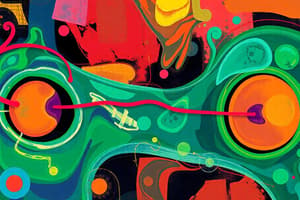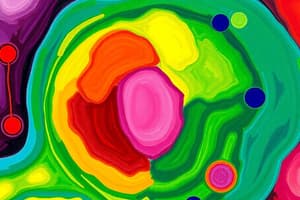Podcast
Questions and Answers
Test tube #1 contains a?
Test tube #1 contains a?
- Lipid
- Nucleic acid
- Carbohydrate (correct)
- Protein
Test tube #2 contains a?
Test tube #2 contains a?
- Lipid
- Nucleic acid
- Carbohydrate
- Protein (correct)
Test tube #3 contains a?
Test tube #3 contains a?
- Carbohydrate
- Lipid (correct)
- Nucleic acid
- Protein
Test tube #4 contains a?
Test tube #4 contains a?
Which of the following would be considered a source of error in Jonathan and Maria's procedure?
Which of the following would be considered a source of error in Jonathan and Maria's procedure?
What would be a valid conclusion from Ray and Abby's data?
What would be a valid conclusion from Ray and Abby's data?
Haploid reproductive cells are:
Haploid reproductive cells are:
Changes in genetic material:
Changes in genetic material:
A diploid cell that results from the fusion of two gametes:
A diploid cell that results from the fusion of two gametes:
A repeating sequence of cellular growth and division:
A repeating sequence of cellular growth and division:
A picture of chromosomes in an individual's cells:
A picture of chromosomes in an individual's cells:
Genes are exchanged between homologous chromosomes during the process called:
Genes are exchanged between homologous chromosomes during the process called:
The random distribution of homologous chromosomes during meiosis is called:
The random distribution of homologous chromosomes during meiosis is called:
Spermatogenesis produces:
Spermatogenesis produces:
Which of the following is true about cell division?
Which of the following is true about cell division?
The process that contributes to the formation of the embryo from the zygote is:
The process that contributes to the formation of the embryo from the zygote is:
The diffusion of water into or out of a cell is called:
The diffusion of water into or out of a cell is called:
Which of the following does not require energy?
Which of the following does not require energy?
A cell will swell when it is placed in a(n):
A cell will swell when it is placed in a(n):
Proteins that act like selective passageways in the cell membrane are known as:
Proteins that act like selective passageways in the cell membrane are known as:
When a signal molecule binds to a receptor protein, the receptor protein may:
When a signal molecule binds to a receptor protein, the receptor protein may:
Proteins and polysaccharides that are too large to move into a cell through diffusion or active transport move in by:
Proteins and polysaccharides that are too large to move into a cell through diffusion or active transport move in by:
The interior portion of a cell membrane forms a nonpolar zone that:
The interior portion of a cell membrane forms a nonpolar zone that:
The selectively permeable membrane and its varied proteins help cells establish:
The selectively permeable membrane and its varied proteins help cells establish:
Which of the following is a form of active transport?
Which of the following is a form of active transport?
Unlike passive transport, active transport:
Unlike passive transport, active transport:
The energy required for active transport mechanisms such as exocytosis and endocytosis is:
The energy required for active transport mechanisms such as exocytosis and endocytosis is:
As a result of diffusion, the concentration of many types of substances:
As a result of diffusion, the concentration of many types of substances:
Ridding the cell of materials by discharging the materials in vesicles is called:
Ridding the cell of materials by discharging the materials in vesicles is called:
Energy is required for a variety of life processes including:
Energy is required for a variety of life processes including:
Light energy is converted to chemical energy through the process of:
Light energy is converted to chemical energy through the process of:
Based on the cycle of photosynthesis and cellular respiration, one can say that the ultimate original source of energy for all living things on Earth is:
Based on the cycle of photosynthesis and cellular respiration, one can say that the ultimate original source of energy for all living things on Earth is:
The source of oxygen produced during photosynthesis is:
The source of oxygen produced during photosynthesis is:
During photosynthesis, the series of reactions that build the carbohydrates needed for energy and growth is called:
During photosynthesis, the series of reactions that build the carbohydrates needed for energy and growth is called:
Enzymes in our body are made up of which biomolecule?
Enzymes in our body are made up of which biomolecule?
Low temperatures may cause photosynthesis to occur:
Low temperatures may cause photosynthesis to occur:
Chemical energy stored in food molecules is released through:
Chemical energy stored in food molecules is released through:
When glycolysis occurs:
When glycolysis occurs:
The process of cellular respiration:
The process of cellular respiration:
The molecule on which an enzyme acts is called a(n):
The molecule on which an enzyme acts is called a(n):
Which of the following is not part of cellular respiration?
Which of the following is not part of cellular respiration?
C6H12O6 + 6O2 => 6CO2 + 6 H2O. This equation begins in the cytoplasm of a cell and ends in the ______.
C6H12O6 + 6O2 => 6CO2 + 6 H2O. This equation begins in the cytoplasm of a cell and ends in the ______.
Cells produce ATP most efficiently in the presence of:
Cells produce ATP most efficiently in the presence of:
A substance that speeds up a chemical reaction, or decreases the required activation energy for a reaction is called a _____.
A substance that speeds up a chemical reaction, or decreases the required activation energy for a reaction is called a _____.
A microscope with a 4´ objective lens and a 10´ ocular lens produces a total magnification of:
A microscope with a 4´ objective lens and a 10´ ocular lens produces a total magnification of:
The smallest units of life are:
The smallest units of life are:
Surface area is an important factor in limiting cell growth because:
Surface area is an important factor in limiting cell growth because:
A structure within a eukaryotic cell that performs a specific function is called a(n):
A structure within a eukaryotic cell that performs a specific function is called a(n):
One difference between prokaryotes and eukaryotes is that:
One difference between prokaryotes and eukaryotes is that:
Which of the following is an example of a prokaryotic cell?
Which of the following is an example of a prokaryotic cell?
Only eukaryotic cells have:
Only eukaryotic cells have:
Many short, hairlike structures that protrude from the surface of a cell and are packed in tight rows are called:
Many short, hairlike structures that protrude from the surface of a cell and are packed in tight rows are called:
The cell membrane:
The cell membrane:
The structure that regulates what enters and leaves the cell is the:
The structure that regulates what enters and leaves the cell is the:
Match the following structures to their functions:
Match the following structures to their functions:
The double membrane surrounding the nucleus is called the:
The double membrane surrounding the nucleus is called the:
One important organelle that helps maintain homeostasis by moving substances from one part of the cell to another is the:
One important organelle that helps maintain homeostasis by moving substances from one part of the cell to another is the:
The Golgi apparatus is an organelle that:
The Golgi apparatus is an organelle that:
The packaging and distribution center of the cell is the:
The packaging and distribution center of the cell is the:
In a cell, proteins are made on the:
In a cell, proteins are made on the:
A cell that requires a lot of energy might contain large numbers of:
A cell that requires a lot of energy might contain large numbers of:
The organelles associated with plant photosynthesis are the:
The organelles associated with plant photosynthesis are the:
Plant cells have a large membrane-bound space in which water, waste products, and nutrients can be stored. This space is called the:
Plant cells have a large membrane-bound space in which water, waste products, and nutrients can be stored. This space is called the:
The smallest particle of matter that can retain the chemical properties of carbon is:
The smallest particle of matter that can retain the chemical properties of carbon is:
A substance that is composed of only one type of atom is called a(n):
A substance that is composed of only one type of atom is called a(n):
The bond formed when two atoms share a pair of electrons is called a:
The bond formed when two atoms share a pair of electrons is called a:
Nonpolar molecules have:
Nonpolar molecules have:
Water is a polar molecule because:
Water is a polar molecule because:
Which of the following is not an organic macromolecule?
Which of the following is not an organic macromolecule?
All organic compounds contain the element:
All organic compounds contain the element:
Which of the following organic molecules are classified as carbohydrates?
Which of the following organic molecules are classified as carbohydrates?
Which of the following organic molecules are most closely related to proteins?
Which of the following organic molecules are most closely related to proteins?
All of the following are examples of lipids except:
All of the following are examples of lipids except:
Which organic molecules below are most closely related to lipids?
Which organic molecules below are most closely related to lipids?
Which of the following organic molecules are most closely related to nucleic acids?
Which of the following organic molecules are most closely related to nucleic acids?
Which of the following is a carbohydrate?
Which of the following is a carbohydrate?
Carbohydrates and lipids have many carbon-hydrogen bonds; therefore, they both:
Carbohydrates and lipids have many carbon-hydrogen bonds; therefore, they both:
Liquid fats called oils contain:
Liquid fats called oils contain:
The two types of nucleic acids are:
The two types of nucleic acids are:
All of the following are examples of carbohydrates except:
All of the following are examples of carbohydrates except:
You are heating a substance in a test tube. All of these are safety precautions you should take except:
You are heating a substance in a test tube. All of these are safety precautions you should take except:
During a lab experiment, a scientist needs to test an unknown sample for the presence of starch. Which solution should the scientist use?
During a lab experiment, a scientist needs to test an unknown sample for the presence of starch. Which solution should the scientist use?
Urinalysis involves testing urine for the presence of specific chemicals. One chemical that is present in the urine of diabetics is glucose. Which solution could be used to determine whether or not glucose is present in the urine?
Urinalysis involves testing urine for the presence of specific chemicals. One chemical that is present in the urine of diabetics is glucose. Which solution could be used to determine whether or not glucose is present in the urine?
Myra's task during a lab experiment was to determine whether a food sample contained fat. Which of the solutions should Myra use to detect fats?
Myra's task during a lab experiment was to determine whether a food sample contained fat. Which of the solutions should Myra use to detect fats?
You are given four test tubes containing purified biological macromolecules. The test tubes are unlabeled except for a number between 1 and 4. You are told that one test tube contains a protein, one contains a lipid, one contains a carbohydrate, and one contains a nucleic acid. You then perform tests on the macromolecules and collect the following information: Test tubes #2 and #4 contain nitrogen, but the other tubes do not. Test tubes #3 are not soluble in water, but the contents of the other test tubes are soluble in water. What can you conclude about the contents of each test tube?
You are given four test tubes containing purified biological macromolecules. The test tubes are unlabeled except for a number between 1 and 4. You are told that one test tube contains a protein, one contains a lipid, one contains a carbohydrate, and one contains a nucleic acid. You then perform tests on the macromolecules and collect the following information: Test tubes #2 and #4 contain nitrogen, but the other tubes do not. Test tubes #3 are not soluble in water, but the contents of the other test tubes are soluble in water. What can you conclude about the contents of each test tube?
Flashcards are hidden until you start studying
Study Notes
Reproductive Cells and Genetic Changes
- Gametes are haploid reproductive cells.
- Mutations signify changes in genetic material.
- A zygote is a diploid cell formed from the fusion of two gametes.
- The cell cycle describes a repeating sequence of cellular growth and division.
- A karyotype is a visual representation of an individual's chromosomes.
Genetic Processes
- Crossing-over is the process where genes are exchanged between homologous chromosomes.
- Independent assortment refers to the random distribution of homologous chromosomes during meiosis.
- Spermatogenesis results in four haploid cells.
- Meiosis produces four genetically different haploid cells, while mitosis results in two identical diploid cells.
- Mitosis is responsible for embryo formation from the zygote.
Cellular Transport Mechanisms
- Osmosis is the diffusion of water into or out of a cell.
- Diffusion does not require energy, while active transport does.
- Cells swell in a hypotonic solution.
- Channel proteins act as selective passageways in cell membranes.
- Endocytosis allows large substances to enter cells that cannot pass through by diffusion or active transport.
Membrane and Homeostasis
- The cell membrane regulates the movement of materials in and out of the cell and is selectively permeable.
- Both equilibrium and homeostasis are achieved through membrane properties and protein functions.
- Active transport mechanisms, like the sodium-potassium pump, require energy.
Energy Transformation and Cellular Respiration
- Photosynthesis converts light energy to chemical energy.
- The ultimate source of energy for life on Earth is the sun.
- The oxygen produced during photosynthesis comes from water.
- The Calvin cycle refers to the reactions that build carbohydrates during photosynthesis.
- Cellular respiration releases chemical energy from food molecules.
Macromolecules and Their Functions
- Enzymes are proteins that catalyze chemical reactions by lowering activation energy.
- Ribosomes are the sites of protein synthesis within cells.
- Mitochondria are abundant in energy-demanding cells due to ATP production.
- Chloroplasts are plant organelles responsible for photosynthesis.
- Vacuoles serve as storage compartments in plant cells.
Chemical Bonds and Molecules
- A carbon atom is the smallest unit that retains the chemical properties of carbon.
- An element consists of one type of atom.
- A covalent bond is formed when two atoms share electrons.
- Nonpolar molecules lack distinct charges, while polar molecules, like water, have partial charges due to uneven electron distribution.
- Organic compounds are distinguished by the presence of carbon.
Carbohydrates, Lipids, and Proteins
- Carbohydrates, including sugars and starches, serve as energy sources and structural components.
- Fatty acids are the building blocks of lipids, which store energy.
- Amino acids are the monomers of proteins, essential for various cellular functions.
- Nucleotides are the basic units of nucleic acids such as DNA and RNA.
- Starch is not a lipid, and ice is not classified as an organic macromolecule.
Laboratory Testing for Macromolecules
- Lugol's solution detects starch.
- Benedict’s solution is used to test for glucose in urine.
- Sudan III identifies fats in food samples.
- Examination of unknown samples in test tubes can help determine the types of biological macromolecules present based on solubility and nitrogen content.### Identification of Macromolecules in Test Tubes
- Test tube #1 contains identical subunits, indicating it is a carbohydrate.
- Test tube #2 shows a globular shape and contains nitrogen, identifying it as a protein.
- Test tube #3 is not soluble in water, suggesting it is a lipid.
- Test tube #4 contains nitrogen as well, matching it with a nucleic acid due to its composition.
Laboratory Experiment Errors and Findings
- Jonathan and Maria's analysis revealed the presence of protein and fat in crackers, despite no mention on the nutritional label.
- Error identified: reuse of test tubes may have introduced contaminants, affecting results.
- Ray and Abby's tests found starch in their cracker slurry, indicating the absence of lipids, proteins, and sugars. This supports the conclusion that crackers primarily consist of starch.
Conclusion from Testing
- Jonathan and Maria's results contrast with their classmates, leading to questions about the reliability of the nutritional information on packaging.
- Ray and Abby confidently conclude that crackers are primarily made of starch and lack other macromolecules tested.
Studying That Suits You
Use AI to generate personalized quizzes and flashcards to suit your learning preferences.





